Keywords |
| LTE-Handover, UE, MUSIC, RLS, LLMS, Griffiths, VSSG |
INTRODUCTION |
| According to the considerable growth of mobile users and high data rate service patterns 4G-LTE expects high data
rate services even in handover region. In the latest wireless systems, multiple-input multiple output (MIMO) has been
used to improve capacity and reliability through the use of spatial diversity or multiplexing transmission.MIMO
(multiple-input - multiple output) systems are those that have multiple antenna elements at both transmitter and
receiver [1].They were first investigated by computer simulations in the 1980s, and later papers explored them
analytically.For single-cell (SC) MIMO adaptation, many previous works have been presented to achieve the capacity
gain through the adoption of statistical beam forming, on ergodic link capacity. However, SC MIMO schemes have
limits to the capacity gain for cell edge users. There have been several papers on multi-cell (MC) MIMO transmission
which have focused on reducing interference at the cell edge using smart scheduling and adaptation strategies
However, the previous MC MIMO methods are inappropriate for handover users because those are based on fast BS
Cooperation. Thus, here we propose a Variable step size Griffith’s algorithms transmission power beam for UE’s that
exploits the better QoS in boundaries of cell where the signal power is less [2]. |
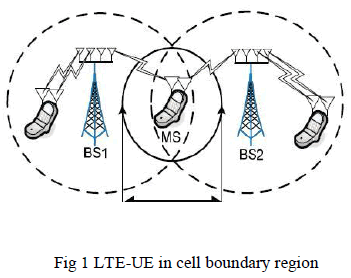 |
| The paper is categorized as, Section (II) MUSIC algorithm for detection of UE at cell boundary regions Section (III)
Implementation of different Beam forming Transmission Algorithms-RLS, LLMS, Griffiths and VSSG. Section (IV)
Capacity computation. |
RELATED WORK |
MULTIPLE SIGNAL CLASSIFICATION (MUSIC) |
| The MUSIC algorithm assures to provide unbiased estimates of the number of signals, the angles of arrival and the
strengths of the waveforms. Here it is assumed that the noise correlation matrix is diagonal. The incident signals may
be correlated creating a non diagonal signal correlation matrix. Because MUSIC exploits the noise Eigen vector
subspace, it is sometimes referred to as a subspace method. |
| The MUSIC pseudo spectrum is given by |
 |
 |
BEAMFORMING TRANSMISSION ALGORITHMS |
| The beam forming algorithms are used to form the main beam towards the detected UE and nulls or reduced beam
towards the interference users [4]. The algorithms for beam forming are – Recursive Least Square (RLS) Algorithm,
Leaky Least Mean Square (LLMS) Algorithm, Griffiths Algorithm and Variable Step Size Griffiths Algorithm. |
A. Recursive Least Square Algorithm |
| The Recursive least square (RLS) is an algorithm which finds recursively the filter coefficients that minimize a
weighted linear least squares cost function relating to the input signals. The autocorrelation matrix for RLS algorithm is
given by |
 |
| Where, X is induced signal, X’ is the transpose of X. |
| The weight vector is given by the equation |
| w (n+1) = w (n) + [ɘ(s(n)-X’ w(n+1))] |
B. Leaky Least Mean Square Algorithm |
| The Eigen value decomposition of autocorrelation matrix Rxx sometimes produces zero Eigen values, then LMS
adaptive filter has more than one modes that are not driven or un-damped. Since it is possible for the un-damped modes
to become unstable, it is important to stabilize the LMS by forcing these modes to zero. One way to accomplish this is
to introduce leakage coefficient ∞ into auto correlation matrix, step size and weight vector equation.The
autocorrelation matrix for Leaky LMS algorithm is given by |
 |
Where, X’ is induced signal, XH is Hermitian transpose of X, ∞ is Leaky Coefficient which takes any value in the range  , I is LxL identity matrix and L is number of antenna elements.
The weight vector is given by the equation , I is LxL identity matrix and L is number of antenna elements.
The weight vector is given by the equation |
 |
C. Griffiths Algorithm |
| Griffiths algorithm makes use of certain priori knowledge (when available) to create an effective real time adaptation
process. The algorithm can be used for a number of applications including Noise Control, Adaptive Beam-forming and
Acoustic Signal Processing. The cross correlation Rsx between the desired signal d(n) and induced signal x(n) is given
by |
 |
| Where,‘d(n)’ is desired signal samples, Ss is number of samples and x(n) is induced signal samples.
The weight update equation for Griffiths algorithm can be derived by using LMS algorithm, which is given by |
 |
| Where, μ is the step size, rsx is the cross- correlation and y(n) is the array output. |
D. Variable Step Size Griffiths Algorithm |
| The motivation behind this algorithm is to get faster convergence through the use of a variable step size LMS algorithm
and a smoother gradient through the use of the Griffiths’ algorithm. It was also observed that the algorithm performed
better with the normalization of gradient. Normalization of the gradient led to a significant drop in the gradient noise.
The step size is calculated by including the constants α and γ The parameter α decides how correlated each step
size value is when compared with the previous step size value and parameter γ decides the measure of increase or
decrease in the step size to be made in accordance with the rise or fall in the prediction error. |
| The weight update equation for VSSG algorithm is given by |
 |
CAPACITY COMPUTATION |
| Before computing the capacity for MIMO systems, first we need to compute the Singular Value decomposition of
the Channel Co-efficient. |
| A = B * D * CT |
| Where, |
| B is an m × k matrix, C is an n × k matrix. |
| D is a k × k matrix, k is the rank of the matrix A. |
| For SISO, |
 |
| For MIMO, |
 |
EXPERIMENTAL RESULTS |
| Figure 2 shows the output of MUSIC method, two users are detected at 30 and 45degrees |
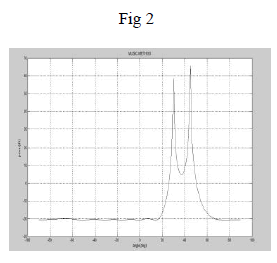 |
| Figure 3 RLS algorithm, the number of antenna elements=8, desired angle=45, number of jammers=1, 1 Jamming
direction=10 |
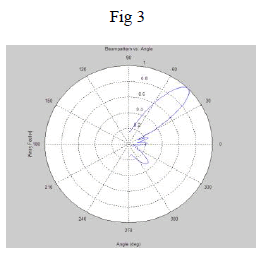 |
| Figure 4 LLMS Algorithm, the number of antenna elements=8, desired angle=30, number of jammers=2, 1 Jamming
direction=10, 2 Jamming direction=20 |
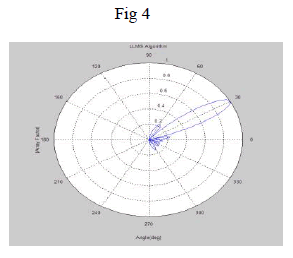 |
| Figure 5 Griffiths Algorithm (a) the number of antenna elements=100, desired angle=45, number of jammers=1, 1
Jamming direction=10. (b) MSE v/s Angle. |
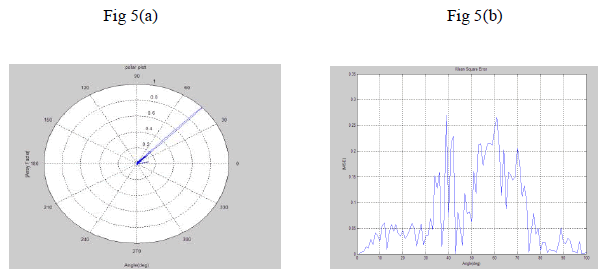 |
| Figure 6 VSSG Algorithm (a) the number of antenna elements=100, desired angle=45, number of jammers=2, 1
Jamming direction=10, 2 Jamming direction=20. (b) Step size variation (c) MSE v/s Angle. |
 |
| Figure 7 Handover with respect to target eNodeB (a) RLS algorithm (b) LLMS algorithm (c) Griffiths algorithm (d)
VSSG algorithm |
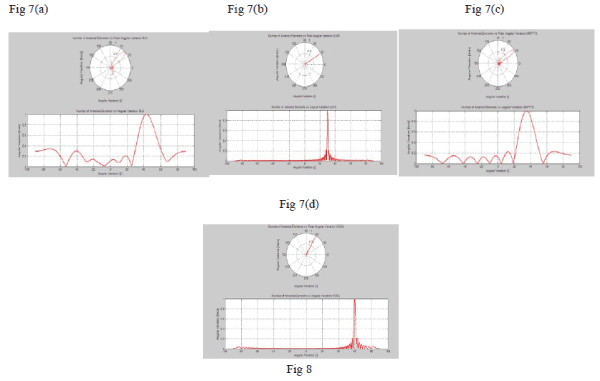 |
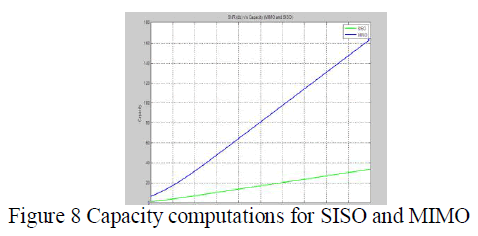 |
CONCLUSION |
| It has been shown that the proposed VSSG algorithm is more efficient for 4G- LTE cell boundary users, where the
transmission signal strength from eNodeB is less to provide the better QoS with less path loss and interference.
Therefore, one can avoid the number iterations and time delay required to converge the Mean square error to zero
during the UE’s handover between source eNodeB to target eNodeB, with respect to different beam steering
algorithms , so that high data service users will maintain the required QoS for the data services without much packet
loss. Using the proposed algorithm with more number of transmitting and receiving antenna (MIMO), the better
Quality of service can be provided without any degradation for handover region users |
References |
- D. Tomecki, S. Stanczak, and M. Kaliszan, âÃâ¬ÃÅJoint optimization of transmit and receive beam-formers in a multicast MIMO system with powercontrol,âÃâ¬Ã in Proc. IEEE Wireless Communications and Networking Conference (WCNC), Budapest, Hungary, April, 5âÃâ¬Ãâ82009.
- H.V.Kumaraswamy, "Implementation of Variable step size Griffiths' algorithm for Adaptive Beam forming", in the IEEE- Internationalsymposium on Microwaves-2008(ISM-08), in ISM- 08 Bangalore, ISM-08 Pages 91-95.Cheng-Chung Lin, Kumbesan Sandrasegaran , ScottReeves , âÃâ¬ÃÅHandover algorithm with joint processing in LTE-advancedâÃâ¬ÃÂ, IEEE ECTI-CON, pp 1-4,May 2012.
- Y. Zhong and X. Chen, âÃâ¬ÃÅMUSIC imaging and electromagnetic inverse scattering of multiply scattering small anisotropic spheres,âÃâ¬Ã IEEE Trans.Antennas Prop, vol. 55, no. 12, pp. 3542âÃâ¬Ãâ3549, 2007.
- H.V.Kumaraswamy, "Comparative analysis of LMS, RLS and other Beam forming methods in smart antenna", in the International conference on computer Communication and Control, Dept. of E & C RVCE Bangalore, 21st âÃâ¬Ãâ 23rd Nov 2007, Comm-11 244-248.
|